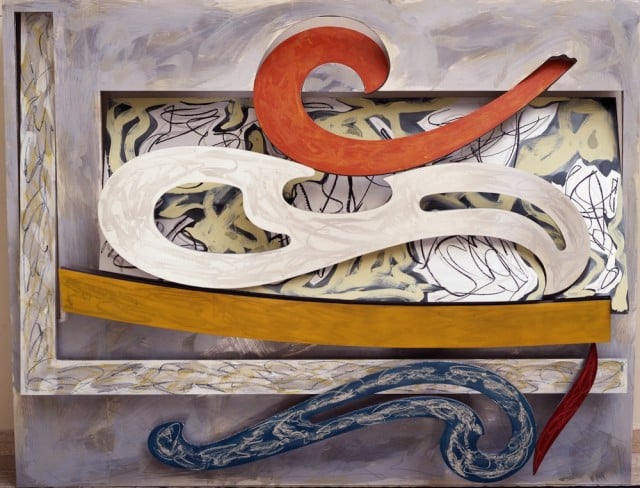Art & Exhibitions
At the Whitney, Frank Stella Pulls Pirouettes
THE DAILY PIC: Stella's 1970s works confront issues of gay and female identity.

THE DAILY PIC: Stella's 1970s works confront issues of gay and female identity.


THE DAILY PIC (#1442): In this Sunday’s New York Times Book Review, I begin my piece on the catalog of the Whitney’s Frank Stella exhibition by claiming that, if you pay close attention, any work of art will give you clues about how it wants to be considered. In the few weeks since writing that, I’ve decided that this is true – but that the job of the critic or art lover is to resist the whispered commands of the work.
Great works of art are, or try to be, cliché-generating machines: They aim to be so potent in their messaging that viewers put aside their critical faculties and simply buy and repeat whatever take on things the art is selling. To use the academic language of my grad-school days, works declare themselves as masterpieces by successfully “naturalizing” their effects – by making them seem necessary and inevitable. A glorious Rembrandt self-portrait convinces us that it captures the angstful soul inside its maker, even though he’s turned that soul into a branded product for sale as art. A great cubist still life sells an image of itself as some new, coherent vision of our modern reality, even if reality is the one thing it barely touches on and incoherence is its central virtue .
A Frank Stella abstraction – to get to our man of the hour – wants us to believe that it is all about giving new life to the fading art of painting, by finding new ways to address the ancient problems of line, form, color, texture and space. Whereas, as I suggest in the Times, those formal problems in fact come freighted with all the normal mess of human social life.
In my book review, I suggested that in contemplating the pin-striped early masterpieces of Stella, the virile collegiate wrestler, we should also keep in mind Dorothy Hamill, the 1970s figure skater whose pirouettes can easily be traced in Stella’s more flamboyant works from that decade – including today’s Pic, titled Eskimo Curlew and made in 1976, the year Hamill won Olympic gold. Stella’s swoopy cut-outs always nuzzled up against the Pattern and Decoration movement that was in play in the same era, and that was always deeply wrapped up in issues of women’s art and women’s esthetics.
Today, I’d also want to invoke Toller Cranston, Hamill’s Canadian colleague who won bronze at that same Olympics in ’76 and whose embrace of gauzy costumes and balletic, “feminine” moves helped change the face of men’s skating. Stella’s own gauzy, flamboyant paintings and reliefs arrived on the scene at just that moment when gay lib was expanding what “manly” could be and the range of behaviors it could safely include. Whether Stella wants it or not – whether his artworks want it or not – we need to see his abstraction as also having a realist’s purchase on such things in the world.
Masterpieces are made stronger – more potent and fecund – when we push back against where they want us to go and take them beyond their comfort zone. (Collection of Portland Art Museum, © 2015 Frank Stella/Artists Rights Society (ARS), New York)
For a full survey of past Daily Pics visit blakegopnik.com/archive.